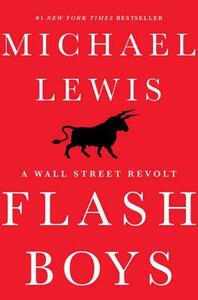Take a photo of a barcode or cover
Easy intro to this topic, even for someone with no knowledge of kickbacks and darkpools etc. Pretty dark, well told - more great stuff from Michael Lewis
Similar in tone and style to previous money-themed Michael Lewis books. More lucidly told than the one about the big crash, not quite as lurid as Liar's Poker. Also, Lewis makes no attempt to hide his perspective (that high frequency trading is evil), so stay away if you disagree. Otherwise, it was great.
informative
fast-paced
The days of men in the bear pit screaming prices at each other are long gone in the stock markets, now days it is all controlled by computers. These are so valuable that they are hidden well away and guarded by heavily armed men, and not even the experts know exactly what happens in these dark pools.
Those that do know won’t tell either, as they are making an absolute fortune.
This market, that we have been assured is open and fair, is rigged. And the key that unlocks the money chest now is speed. These days when you place and order for shares it is transmitted to an exchange so you can carry out the transactions. Whilst this is really fast, there are guys called high frequency traders who see your order, and with their super fast networks buy the shares first before offering them to you for a few pennies more. They have almost no risk as they have a guaranteed buyer. All because their connection is that few seconds faster.
One man, Brad Katsuyama, sees this happening and decides to do something to try and make the markets fair once again. With and eclectic bunch of financial oddballs and misfits, he sets up his own exchange, IDX, that is not only transparent, but also has a declared set of rules. Lewis writes about the fight that he went through to become accepted in Wall Street, how banks still refused to trade with them, even when explicitly told to do so by their customers as they couldn’t take a cut from their high frequency traders.
Lewis does have a way of getting complex financial shenanigans across, and in this book he has a good go at it. But there is masses of technical jargon in here, and that does get in the way of the story of Katsuyama’s fight to have an open and equal market once again. It was worth reading though, just to see how rigged and corrupt the world financial markets are.
Those that do know won’t tell either, as they are making an absolute fortune.
This market, that we have been assured is open and fair, is rigged. And the key that unlocks the money chest now is speed. These days when you place and order for shares it is transmitted to an exchange so you can carry out the transactions. Whilst this is really fast, there are guys called high frequency traders who see your order, and with their super fast networks buy the shares first before offering them to you for a few pennies more. They have almost no risk as they have a guaranteed buyer. All because their connection is that few seconds faster.
One man, Brad Katsuyama, sees this happening and decides to do something to try and make the markets fair once again. With and eclectic bunch of financial oddballs and misfits, he sets up his own exchange, IDX, that is not only transparent, but also has a declared set of rules. Lewis writes about the fight that he went through to become accepted in Wall Street, how banks still refused to trade with them, even when explicitly told to do so by their customers as they couldn’t take a cut from their high frequency traders.
Lewis does have a way of getting complex financial shenanigans across, and in this book he has a good go at it. But there is masses of technical jargon in here, and that does get in the way of the story of Katsuyama’s fight to have an open and equal market once again. It was worth reading though, just to see how rigged and corrupt the world financial markets are.
Scary stuff, makes the events leading up to the 29 crash look like a minor clerical error. One of the more under-focused aspects of this book are the security and infrastructure risks in the data usage of Wall Street, possibly as impactful as the risk in the financial models.
This explained a complex topic in a readable and understandable way. Fascinating!
Interesting and digestible view into high frequency trading. Not a topic I thought I would love, much less one that I knew anything about before, but Lewis breaks down complex concepts to be incredible simple. His writing style also made this seem like more of a narrative and less of a lecture. Towards the end I was genuinely curious about the individuals involved and their insights into the industry. Learned a lot and enjoyed it more than I thought.
Not his best, but an interesting read nonetheless. At times the minutiae on the types of trades bored me, but the devil lies in the details. I found Sergey's story to be the most heart-wrenching.
A good description on high frequency trading, but it's such a complicated topic that I don't think Lewis delves into the details. Mainly because they are difficult to comprehend and not many people know it in depth. Lewis has been honest in saying in interviews that the topic is dense and debatable. However, as always an entertaining read in the usual Lewis style.





